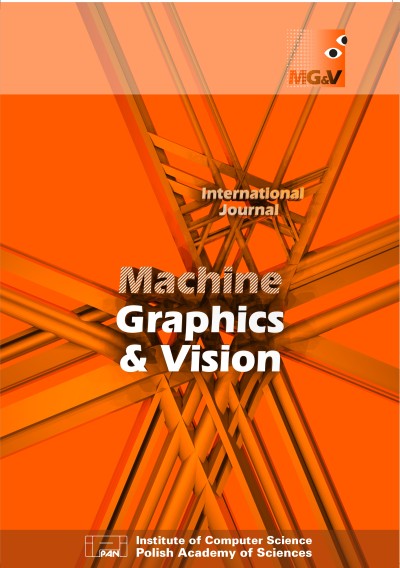Main Article Content
Article Details
A. Michelson. Studies in Optics. Univ. of Chicago Press, 1927.
H. S. M. Coxeter. Introduction to Geometry, 2nd Ed. Wiley, 1969.
M. Brady, J. Ponce, A. L. Yuille, and H. Asada. Describing surfaces. Comput. Vision, Graphics, and Image Process., 32(1):1–28, 1985. (Crossref)
H. Kukkonen, J. Rovamo, K. Tiippana, and R. Näsänen. Michelson contrast, RMS contrast and energy of various spatial stimuli at threshold. Vision Research, 33(10):1431–1436, 1993. (Crossref)
M. C. Morrone, D. C. Burr, and L. M. Vaina. Two stages of visual processing for radial and circular motion. Nature, 376(6540):507–509, 1995. (Crossref)
P. Cignoni, C. Rocchini, and R. Scopigno. Metro: measuring error on simplified surfaces. Comput. Graphics Forum, 17(2):167–174, 1998. (Crossref)
P. G. Engeldrum. Psychometric Scaling: A Toolkit for Imaging Systems Development. Imcotek Press, 2000.
A. Hertzmann and D. Zorin. Illustrating smooth surfaces. In Proc. of ACM Siggraph, pages 517–526, 2000. (Crossref)
Z. Karni and C. Gotsman. Spectral compression of mesh geometry. In Proc. of ACM Siggraph, pages 279–286, 2000. (Crossref)
B.-E. Rogowitz and H.-E. Rushmeier. Are image quality metrics adequate to evaluate the quality of geometric objects. In Proc. of Human Vision and Electronic Imaging, pages 340–348, 2001. (Crossref)
N. Aspert, D. Santa-Cruz, and T. Ebrahimi. MESH: measuring errors between surfaces using the Hausdorff distance. In Proc. of IEEE Int. Conf. on Multimedia & Expo, pages 705–708, 2002.
P. Alliez, D. Cohen-Steiner, O. Devillers, B. L´evy, and M. Desbrun. Anisotropic polygonal remeshing. ACM Trans. on Graphics, 22(3):485–493, 2003. (Crossref)
D. Cohen-Steiner and J. M. Morvan. Restricted Delaunay triangulations and normal cycle. In Symp. on Computational Geometry, pages 312–321, 2003. (Crossref)
O. Sorkine, D. Cohen-Or, and S. Toledo. High-pass quantization for mesh encoding. In Proc. of Eurographics/ACM Siggraph Symp. on Geometry Process., pages 42–51, 2003.
Z. Wang and X. Shang. Spatial pooling strategies for perceptual image quality assessment. In Proc. of IEEE Int. Conf. on Image Process., pages 2945–2948, 2003.
Z. Wang, A. C. Bovik, H. R. Sheikh, and E. P. Simoncelli. Image quality assessment: From error visibility to structural similarity. IEEE Trans. on Image Process., 13(4):600–612, 2004. (Crossref)
G. Lavoué, E. Drelie Gelasca, F. Dupont, A. Baskurt, and T. Ebrahimi. Perceptually driven 3D distance metrics with application to watermarking. In Proc. of SPIE Electronic Imaging, pages 63120L.1–63120L.12, 2006. (Crossref)
O. Sorkine. Differential representations for mesh processing. Comput. Graphics Forum, 25(4):789–807, 2006. (Crossref)
Z. Wang and A. C. Bovik. Modern Image Quality Assessment. Morgan & Claypool, 2006. (Crossref)
B. G. Breitmeyer. Visual masking: past accomplishments, present status, future developments. Advances in Cognitive Psychology, 3(1-2):9–20, 2007. (Crossref)
J.-W. Cho, R. Prost, and H.-Y. Jung. An oblivious watermarking for 3-D polygonal meshes using distribution of vertex norms. IEEE Trans. on Signal Process., 55(1):142–155, 2007. (Crossref)
M. Corsini, E. Drelie Gelasca, T. Ebrahimi, and M. Barni. Watermarked 3-D mesh quality assessment. IEEE Trans. on Multimedia, 9(2):247–256, 2007. (Crossref)
F. Cole, A. Golovinskiy, A. Limpaecher, H.-S. Barros, A. Finkelstein, T. Funkhouser, and S. Rusinkiewicz. Where do people draw lines? ACM Trans. on Graphics, 27(3):88:1–88:11, 2008. (Crossref)
B. Vallet and B. Lévy. Spectral geometry processing with manifold harmonics. Comput. Graphics Forum, 27(2):251–260, 2008. (Crossref)
Z. Bian, S.-M. Hu, and R. R. Martin. Evaluation for small visual difference between conforming meshes on strain field. J. of Comput. Sci. and Technol., 24(1):65–75,2009. (Crossref)
G. Lavoué. A local roughness measure for 3D meshes and its application to visual masking. ACM Trans. on Appl. Perception, 5(4):21:1–21:23, 2009. (Crossref)
Q. Li and Z. Wang. Reduced-reference image quality assessment using divisive normalization-basedimage representation. IEEE J. Sel. Topics Signal Process., 3(2):202–211, 2009. (Crossref)
S. Silva, B. S. Santos, C. Ferreira, and J. Madeira. A perceptual data repository for polygonal meshes. In Proc. of Int. Conf. in Visualization, pages 207–212, 2009. (Crossref)
Z. Wang and A. C. Bovik. Mean squared error: love it or leave it? — A new look at signal fidelity measures. IEEE Signal Process. Magazine, 26(1):98–117, 2009. (Crossref)
M. Botsch, L. Kobbelt, M. Pauly, P. Alliez, and B. L´evy. Polygon Mesh Processing. AK Peters, 2010. (Crossref)
G. Lavoué and M. Corsini. A comparison of perceptually-based metrics for objective evaluation of geometry processing. IEEE Trans. on Multimedia, 12(7):636–649, 2010. (Crossref)
G. Lavoué. A multiscale metric for 3D mesh visual quality assessment. Comput. Graphics Forum, 30(5):1427–1437, 2011. (Crossref)
K. Wang, G. Lavoué, F. Denis, and A. Baskurt. Robust and blind mesh watermarking based on volume moments. Comput. & Graphics, 35(1):1–19, 2011. (Crossref)
Z. Wang and A. C. Bovik. Reduced- and no-reference image quality assessment. IEEE Signal Process. Magazine, 28(6):29–40, 2011. (Crossref)
P. Alliez, S. Tayeb, and C. Wormser. 3D fast intersection and distance computation (AABB tree). In CGAL User and Reference Manual, 2012.
F. Torkhani, K. Wang, and J.-M. Chassery. A curvature tensor distance for mesh visual quality assessment. In Proc. of Int. Conf. on Computer Vision and Graphics, pages 253–263, 2012. (Crossref)
L. Váša and J. Rus. Dihedral angle mesh error: a fast perception correlated distortion measure for fixed connectivity triangle meshes. Comput. Graphics Forum, 31(5):1715–1724, 2012. (Crossref)
K. Wang, F. Torkhani, and A. Montanvert. A fast roughness-based approach to the assessment of 3D mesh visual quality. Comput. & Graphics, 36(7):808–818, 2012. (Crossref)
M. Corsini, M. C. Larabi, G. Lavoué, O. Petřík, L. Váša, and K. Wang. Perceptual metrics for static and dynamic triangle meshes. Comput. Graphics Forum, 32(1):101–125, 2013. (Improved version of Eurographics 2012 state-of-the-art report). (Crossref)
G. Lavoué. Erratum of the Results of Mesh Visual Quality Metrics (Available on-line at http://liris.cnrs.fr/glavoue/travaux/Erratum.html), 2013.





